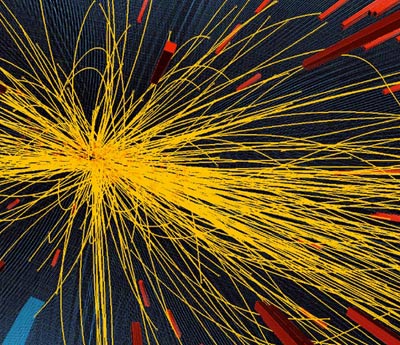After almost six months of operation in a new energy region, the experiments at the LHC are yielding papers on physics at 7 TeV in the centre-of-mass. They include results aired at the International Conference on High-Energy Physics in Paris in July.

At the end of September, the CMS collaboration announced the observation of intriguing correlations between particles produced in proton–proton collisions at 7 TeV. It measured two-particle angular correlations in collisions at 0.9, 2.36 and 7 TeV – the three centre-of-mass energies at which the LHC has run. At 7 TeV, a pronounced structure emerges in the two-dimensional correlation function for particle pairs in high-multiplicity events, with at least 100 charged particles and a transverse momentum of 1–3 GeV/c. The ridge-like structure occurs at ΔΦ (a measure of the difference in transverse angle) near zero and spans a rapidity range of 2.0 <|Δη| <4.8 (CMS collaboration 2010). This implies that some pairs of particles emerging with a wide longitudinal angle (which is related to Δη) are closely correlated in transverse angle. The effect bears some similarity to those already seen in heavy-ion collisions at the Relativistic Heavy Ion Collider at the Brookhaven National Laboratory, which have been linked to the formation of hot, dense matter in the collisions. However, as the CMS collaboration stresses, there are several potential explanations.
These developments will be of interest to the ALICE collaboration, whose detector is optimized for the study of heavy-ion collisions at the LHC, the first period of which is scheduled to begin in November. In the meantime, one of the interesting results from ALICE in proton–proton collisions concerns the ratio of the yields of antiprotons to protons at both 0.9 TeV and 7 TeV. The measurement relates to the question of whether baryon number can transfer from the incoming beams to particles emitted transversely (at mid-rapidity). Any excess of protons over antiprotons would indicate such a transfer, which would be related to the slowing down of the incident proton. The results show that the ratio rises from about 0.95 at 0.9 TeV to close to 1 at 7 TeV and is independent of both rapidity and transverse momentum (ALICE collaboration 2010). These findings are consistent with the conventional model of baryon-number transport, setting stringent limits on any additional contributions.
In the search for new physics, the ATLAS experiment recently set new limits on the mass of excited quarks by looking in the mass distributions of two-jet events, or dijets. Now, the collaboration has also produced the first measurements of cross-sections for the production of jets in proton–proton collisions at 7 TeV. It has measured inclusive single-jet differential cross-sections as functions of the jet’s transverse momentum and rapidity and dijet cross-sections as functions of the dijet’s mass and an angular variable Χ. The results agree with expectations from next-to-leading-order QCD, so providing a validation of the theory in a new kinematic regime.
The LHCb collaboration is also measuring cross-sections in the LHC’s new energy region. With its focus on the physics of b quarks, the experiment has looked, for example, at the decays of b hadrons into final states containing a D0 meson and a muon to measure the bb production cross-section at 7 TeV (LHCb collaboration 2010). While some earlier results on the production of b-flavoured hadrons at 1.8 TeV at the Tevatron appeared to be higher than theoretical predictions, more recent measurements there at 1.96 TeV by the CDF experiment were consistent with theory. Now, LHCb’s results have extended the measurements to a much higher centre-of-mass energy – and again show consistency with theory, this time at 7 TeV. Such measurements of particle yields are vital to LHCb in assessing the sensitivity for studying fundamental parameters, for example, in CP violation.





